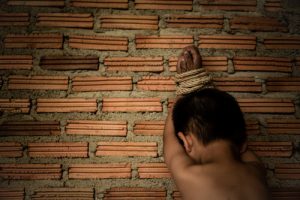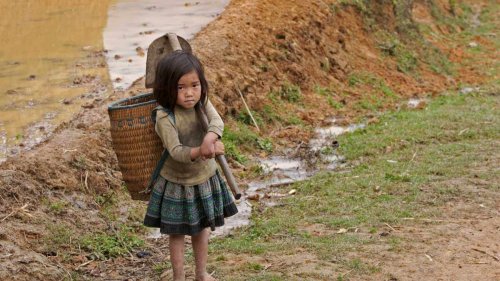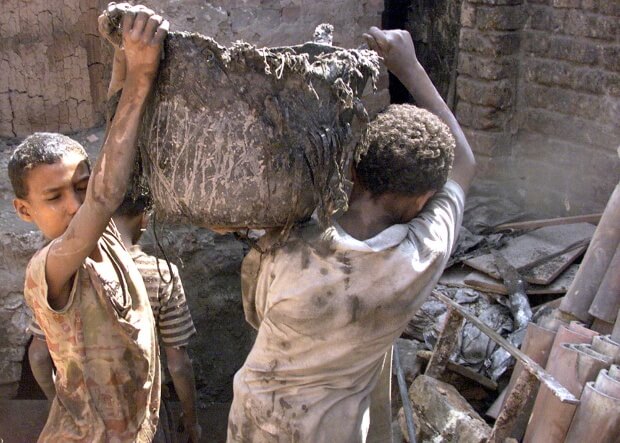How Much Do You Really Know About Children's Rights?

Have you ever asked yourself about children’s rights? What are they? Are they respected? Who makes sure they’re enforced?
Many times we take children’s rights for granted without really knowing what they’re about. The concept often seems abstract or hard to grasp.
Children’s happiness, laughter and innocence reawaken our often weakened optimism. They remind us that even as adults, we still possess the abilities of wonder, hope and joy.
Without children we would never be able to remember that we were once kids ourselves. We played outdoors under the sun and discovered a world that was completely new to us. We also once believed that anything was possible… But to what end?
Unfortunately, many children don’t have the childhood they deserve. There are thousands of children who must face injustice every day, and who are deprived of any chance of experiencing a happy childhood.
Historical summary
In the 19th and early 20th century, when no adult was present to help children, many of them had no other option than to leave school and join the work force.
They were orphans in every sense of the word. It didn’t matter how old a child was or what his physical conditions were. Factories were only interested in having cheap labor and making profits.
Children were forced to work in mines and factories in almost slave-like conditions, earning pennies. Girls were subject to the same reality, however many of them were also forced into prostitution.
For this reason, activists created organizations to help defend the fundamental rights of children.
During the 19th centry, orphan children found themselves in a situation of complete abandonment. For that reason, during this time period, movements to support children were at the peak.
An alarming number of children were living in despair, especially during the first and second World Wars. This caught the attention of the League of Nations, which decided to take action.
That’s how, in 1924, the Geneva Declaration came into existence. This declaration officially recognized children’s rights for the first time.

What rights do children have?
Children are human beings with inalienable rights. In the year 1989, in a series of declarations and gatherings, the current Convention on the Rights of the Child was created.
This treaty recognized for the first time that children deserved their own rights. This concept meant a definitive break with previous paradigms.
The 193 countries involved in the signing of the treaty set out to develop alternatives to protect children and protect their interests. They committed themselves to fighting this battle.
This same treaty consists of 54 articles in total, that can be divided into 5 basic rights or guiding principles. These rights are considered untouchable, no matter what the laws, culture and opinions of the participating countries may be.
1. The right to live without discrimination
All children have the same rights. A child’s physical characteristics, economic status, race, gender or sexual identity don’t affect his or her rights. Just as with adults, children should be respected and treated as valuable human beings.
2. The right to life, survival and full development
Every child has the right to have his survival protected. Children need to develop in an adequate environment, with sufficient food and an education. A lack of resources can often cause emotional and physical problems that the child carries into adulthood.

3. The right to participation
Even the smallest of children have the right to have their opinions heard. It doesn’t matter what a child’s age or abilities are – they should be consulted in regards to any situation that affects them. This also includes their right to expression, which is just as valid as the right of an adult.
4. The right to decent housing
The right to decent housing is one of the most well-known children’s rights. Children need to live in an adequate environment where they are free from fear and danger. Children should be provided with a safe space where they can develop correctly.
5. Best interest of the child
Any decision or law that applies to a case with minors must be made according to what is best for the child. This right may conflict with their right to participation, because often what children want is not what’s best for them.
Children’s rights today
The General Assembly of the United Nations approved and ratified these children’s rights. However, they aren’t always respected.
There are still countries that allow for child labor and even regulate it. In those countries, children work many more hours than what is even recommended for an adult. What’s more, the condition in which they work are not fit for humans.
In many places around the world, the lives of children are given no value. For a variety of circumstances, a great number of children end up in mafia networks and are often used as objects of sexual exchange.
Those who carry out these transactions are individuals who don’t care at all about the damage they cause to children. They only care about receiving the benefits and carrying on with their “business.” This can occur anywhere, not only in third world countries, but in the first world as well.
Many non-profit and non-government organizations have been fighting against this problem for years. Thanks to them, it’s possible to rescue many children and offer them the things their oppressors deprived them of. This includes food, a roof over their heads, and the warmth of a home.
There are diverse programs whose aim is to rescue every child that is in a situation of disadvantage, poverty and the like. Through their efforts, the children recieve food, a home, and even resources to continue on with their lives. This, of course, includes education.
Who guarantees children their rights?
Any organization that works in favor of children does its part to promote their rights. However, the organization that is officially responsible for safeguarding children’s rights is UNICEF. The United Nations specifically created UNICEF to give humanitarian aid to children and mothers in developing countries.
We need to become aware of the reality in which many children live. Whether we have experienced difficulties in our own childhood, we must understand that we can battle against abuse and neglect. In fact, we can even become involved from our own homes.
It’s about searching for alternatives. Without a doubt, there is a great number and variety of options. So let’s be agents of change and work together to give children what they so badly need.
Thankfully, we live in a country that respects the rights of our children. But we should never forget that other children aren’t as fortunate. We have the power to fight and provide a better situation for these precious little ones.
Have you ever asked yourself about children’s rights? What are they? Are they respected? Who makes sure they’re enforced?
Many times we take children’s rights for granted without really knowing what they’re about. The concept often seems abstract or hard to grasp.
Children’s happiness, laughter and innocence reawaken our often weakened optimism. They remind us that even as adults, we still possess the abilities of wonder, hope and joy.
Without children we would never be able to remember that we were once kids ourselves. We played outdoors under the sun and discovered a world that was completely new to us. We also once believed that anything was possible… But to what end?
Unfortunately, many children don’t have the childhood they deserve. There are thousands of children who must face injustice every day, and who are deprived of any chance of experiencing a happy childhood.
Historical summary
In the 19th and early 20th century, when no adult was present to help children, many of them had no other option than to leave school and join the work force.
They were orphans in every sense of the word. It didn’t matter how old a child was or what his physical conditions were. Factories were only interested in having cheap labor and making profits.
Children were forced to work in mines and factories in almost slave-like conditions, earning pennies. Girls were subject to the same reality, however many of them were also forced into prostitution.
For this reason, activists created organizations to help defend the fundamental rights of children.
During the 19th centry, orphan children found themselves in a situation of complete abandonment. For that reason, during this time period, movements to support children were at the peak.
An alarming number of children were living in despair, especially during the first and second World Wars. This caught the attention of the League of Nations, which decided to take action.
That’s how, in 1924, the Geneva Declaration came into existence. This declaration officially recognized children’s rights for the first time.

What rights do children have?
Children are human beings with inalienable rights. In the year 1989, in a series of declarations and gatherings, the current Convention on the Rights of the Child was created.
This treaty recognized for the first time that children deserved their own rights. This concept meant a definitive break with previous paradigms.
The 193 countries involved in the signing of the treaty set out to develop alternatives to protect children and protect their interests. They committed themselves to fighting this battle.
This same treaty consists of 54 articles in total, that can be divided into 5 basic rights or guiding principles. These rights are considered untouchable, no matter what the laws, culture and opinions of the participating countries may be.
1. The right to live without discrimination
All children have the same rights. A child’s physical characteristics, economic status, race, gender or sexual identity don’t affect his or her rights. Just as with adults, children should be respected and treated as valuable human beings.
2. The right to life, survival and full development
Every child has the right to have his survival protected. Children need to develop in an adequate environment, with sufficient food and an education. A lack of resources can often cause emotional and physical problems that the child carries into adulthood.

3. The right to participation
Even the smallest of children have the right to have their opinions heard. It doesn’t matter what a child’s age or abilities are – they should be consulted in regards to any situation that affects them. This also includes their right to expression, which is just as valid as the right of an adult.
4. The right to decent housing
The right to decent housing is one of the most well-known children’s rights. Children need to live in an adequate environment where they are free from fear and danger. Children should be provided with a safe space where they can develop correctly.
5. Best interest of the child
Any decision or law that applies to a case with minors must be made according to what is best for the child. This right may conflict with their right to participation, because often what children want is not what’s best for them.
Children’s rights today
The General Assembly of the United Nations approved and ratified these children’s rights. However, they aren’t always respected.
There are still countries that allow for child labor and even regulate it. In those countries, children work many more hours than what is even recommended for an adult. What’s more, the condition in which they work are not fit for humans.
In many places around the world, the lives of children are given no value. For a variety of circumstances, a great number of children end up in mafia networks and are often used as objects of sexual exchange.
Those who carry out these transactions are individuals who don’t care at all about the damage they cause to children. They only care about receiving the benefits and carrying on with their “business.” This can occur anywhere, not only in third world countries, but in the first world as well.
Many non-profit and non-government organizations have been fighting against this problem for years. Thanks to them, it’s possible to rescue many children and offer them the things their oppressors deprived them of. This includes food, a roof over their heads, and the warmth of a home.
There are diverse programs whose aim is to rescue every child that is in a situation of disadvantage, poverty and the like. Through their efforts, the children recieve food, a home, and even resources to continue on with their lives. This, of course, includes education.
Who guarantees children their rights?
Any organization that works in favor of children does its part to promote their rights. However, the organization that is officially responsible for safeguarding children’s rights is UNICEF. The United Nations specifically created UNICEF to give humanitarian aid to children and mothers in developing countries.
We need to become aware of the reality in which many children live. Whether we have experienced difficulties in our own childhood, we must understand that we can battle against abuse and neglect. In fact, we can even become involved from our own homes.
It’s about searching for alternatives. Without a doubt, there is a great number and variety of options. So let’s be agents of change and work together to give children what they so badly need.
Thankfully, we live in a country that respects the rights of our children. But we should never forget that other children aren’t as fortunate. We have the power to fight and provide a better situation for these precious little ones.
All cited sources were thoroughly reviewed by our team to ensure their quality, reliability, currency, and validity. The bibliography of this article was considered reliable and of academic or scientific accuracy.
- Casas-Muñoz, A., & Loredo-Abdalá, A. (2014). ¿ Por qué debemos conocer los derechos de niñas, niños y adolescentes?. Acta pediátrica de México, 35(6), 437-439. https://www.medigraphic.com/pdfs/actpedmex/apm-2014/apm146a.pdf
- MacCormick, N. (1988). Los derechos de los niños: una prueba de fuego para las teorías de los derechos. Anuario de filosofía del derecho, (5), 293-306. https://dialnet.unirioja.es/descarga/articulo/142142.pdf
This text is provided for informational purposes only and does not replace consultation with a professional. If in doubt, consult your specialist.








